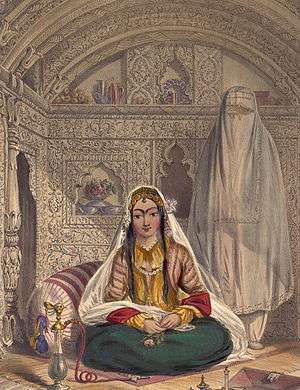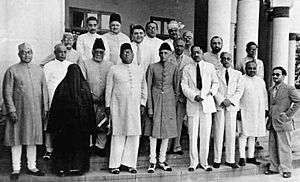Purdah
Purdah or pardah (from Persian: پرده, meaning "curtain") is a religious and social practice of female seclusion prevalent among some Muslim communities in South Asia. The variation of purdah worn by Hindu women is known as Ghoonghat. It takes two forms: physical segregation of the sexes and the requirement that women cover their bodies so as to cover their skin and conceal their form. A woman who practices purdah can be referred to as pardanashin or purdahnishan.
Physical segregation within buildings is achieved with judicious use of walls, curtains, and screens. A woman's withdrawal into purdah usually restricts her personal, social and economic activities outside her home. The usual purdah garment worn is a burqa, which may or may not include a yashmak, a veil to conceal the face. The eyes may or may not be exposed.
Purdah was rigorously observed under the Taliban in Afghanistan, where women had to observe complete purdah at all times when they were in public. Only close male family members and other women were allowed to see them out of purdah. In other societies, purdah is often only practised during certain times of religious significance.
Married Hindu women in parts of Northern India observe ghoonghat in the presence of older male relations on their husbands' side. This custom is not followed by Hindu women elsewhere in India.
Origins
Pre-Islamic roots
Although purdah is commonly associated with Islam, many scholars argue that veiling and secluding women pre-dates Islam; these practices were commonly found among various groups in the Middle East such as Druze, Christian, and Jewish communities.[1] For instance, the burqa existed in Arabia before Islam, and the mobility of upper-class women was restricted in Babylonia, Persian, and Byzantine Empires before the advent of Islam.[2] Historians believe purdah was acquired by the Muslims during the expansion of the Arab Empire into modern-day Iraq in the 7th century C.E and that Islam merely added religious significance to already existing local practices of the times.[3]
Adoption and spreading
Historians believe purdah was originally a Persian (Nestorian Christians) practice that the Muslims adopted during the Arab conquest of modern-day Iraq in the 7th century C.E. .[3] Later, Muslim rule of northern India during the Mughal Empire influenced the practice of Hinduism, and the purdah spread to the Hindu upper classes of northern India.[3] The spread of purdah outside of the Muslim community can be attributed to the tendency of affluent classes to mirror the societal practices of the nobility; poor women did not observe purdah. Lower class women in small villages often worked in fields, and therefore could not afford to abandon their work to be secluded.[4] During the British colonialism period in India, purdah observance was widespread and strictly-adhered to among the Muslim minority.[3]
In modern times, the practice of veiling and secluding women is still present in mainly Islamic countries and South Asian countries.[3] However, the practice is not monolithic. Purdah takes on different forms and significance depending on the region, time, socioeconomic status, and local culture.[5] It is most commonly associated with some Muslim communities in Afghanistan and Pakistan, along with Saudi Arabia.[6] Purdah has been more recently adopted in northern Nigeria, especially in areas affected by the Boko Haram uprising.[7] It is also observed by Rajput clans of India and Pakistan as a social practice regardless of religion.[8]
Rationale
Protection and patriarchy
Some scholars argue that purdah was initially designed to protect women from being harassed, but later these practices became a way to justify efforts to subjugate women and limit their mobility and freedom.[1] However, others argue that these practices were always in place as local custom, but were later adopted by religious rhetoric to control female behavior.[9]
Respect
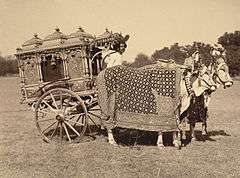
Proponents of the practice view purdah as a symbol of honor, respect, and dignity. It is seen as a practice that allows women to be judged by their inner beauty rather than physical beauty.[10]
Economic
In many societies, the seclusion of women to the domestic sphere is a demonstration of higher socioeconomic status and prestige because women are not needed for manual labor outside the home.[11]
Individual motivations
The rationales of individual women for keeping purdah are complex and can be a combination of motivations, freely chosen or in response to social pressure or coercion: religious, cultural (desire for authentic cultural dress), political (Islamization of the society), economic (status symbol, protection from the public gaze), psychological (detachment from public sphere to gain respect), fashion and decorative purposes, and empowerment (donning veils to move in public space).[5]
Example of purdah
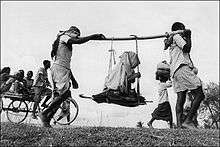
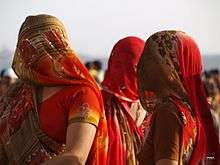
The following reminiscence from C.M. Naim, describes the evolution of purdah during the first third of the 20th century among the sharif or genteel people of Avadh, United Provinces, British India:[12]
The word ‘Hijab' is relatively new for me. It was not a part of my vocabulary as I was growing up. I learned it much later, when I began to read literary and religious Urdu texts. ... The relevant word that I learned growing up was purdah. And I learned the word and its many meanings in the observed practice of the various female members of my middle-class family in Bara Banki, a small town in north India.
For Ammi, my grandmother, purdah meant almost never venturing out of the house. On the rare occasions when she did, it was always an elaborate ritual. Visiting a family in the neighbourhood -- only on the occasion of some tragedy, ... she used a doli. The little stool slung from a pole that two men carried would be brought to our back door -- the door to the zanana or the ladies' section -- and the two carriers would step away behind the curtain wall. Ammi would wrap herself in a white sheet and squat on the flat stool, and a heavy custom-made cover would be thrown over her and the doli. The two bearers would then come back and carry the doli away on their shoulders. ... When Ammi traveled in my father's car, she covered herself the same way, while the back seat of the car where she sat was made completely invisible by pieces of cloth hung across the windows.
Apa, my mother, belonged to the next generation. She used a burqa. Hers was a two piece ‘modern' outfit, as opposed to the one-piece -- derisively called ‘the shuttlecock' by my sisters -- that was preferred by the older or more conservatively spirited in the family. I also remember that the older generation's burqas were usually white, while the new burqas were always black.
A different form of veiling, the ghoonghat, is found among some married Hindu women in rural North India. A fold of the sari is drawn over the face when the woman is in the presence of older male in-laws or in a place where there is likelihood of meeting them, e.g. the in-laws' village. It is not worn otherwise, for example, when visiting her mother's home or in a location far from the in-laws' village. Hindu women in other parts of India—south, east, west (below Gujarat)—do not veil themselves.
Conduct and seclusion
Another important aspect of purdah is modesty for women, which includes minimizing the movement of women in public spaces and interactions of women with other males. The specific form varies widely based on religion, region, class, and culture. For instance, for some purdah might mean never leaving the home unless accompanied by a male relative, or limiting interactions to only other women and male relatives (for some Muslims) or avoiding all males outside of the immediate family (for some Hindus).[13] For Muslims, seclusion begins at puberty while for Hindus, seclusion begins after marriage.[13]
Effects
Psychology and health
By restricting women's mobility, purdah results in the social and physical isolation of women.[14] Lack of a strong social network places women in a position of vulnerability with her husband and her husband's family. Studies have shown that in conservative rural Bangladeshi communities, adherence to purdah is positively correlated with the risk of domestic violence.[14] The restriction on women's mobility limits their ability to access health care and family planning services, especially for unmarried girls. In rural Pakistan, unmarried women and girls had trouble accessing healthcare facilities even in their own villages due to purdah; all types of women had difficulty accessing facilities outside of their villages because they had to be accompanied.[15] Along the same vein, studies of women's contraceptive use in Bangladesh shows that women with decreased observance of purdah and increased mobility are more likely to use contraceptives.[16]
Economic participation
By restricting women's mobility, purdah places severe limits on women's ability to participate in gainful employment and to attain economic independence.[17] The ideology of purdah constricts women in the domestic sphere for reproductive role and places men in productive role as breadwinners who move through public space.[5] However, due to economic needs and shifts in gender relations, some women are compelled to break purdah to gain income.[5] Across countries, women from lower socioeconomic backgrounds tend to observe purdah less because they face greater financial pressures to work and gain income.[5] Studies show that "it is the poorest, most desperate families that, given the opportunity, are more willing to stress purdah norms and take the social risks entailed when women engage in wage or self-employment.[17] For instance, rural women in Bangladesh have been found to be less concerned with propriety and purdah, and take up work where available, migrating if they need to.[18] They take up work in a variety of sectors from agriculture to manufacturing to the sex trade. However, other studies found that purdah still plays a significant role in women's decisions to participate in the workforce, often prohibiting them from taking opportunities they would otherwise.[19] The degree to which women observe purdah and the pressures they face to conform or to earn income vary with their socioeconomic class.
Political participation
Social and mobility restrictions under purdah severely limit women's involvement in political decision making in government institutions and in the judiciary.[5] Lack of mobility and discouragement from participating in political life means women cannot easily exercise their right to vote, run for political office, participate in trade unions, or participate in community level decision-making.[9] Women's limited participation in political decision-making therefore results in policies that do not sufficiently address needs and rights of women in areas such as access to healthcare, education and employment opportunities, property ownership, justice, and others.[5] Gender imbalance in policy-making also reinforces institutionalization of gender disparities.[5]
Influences on purdah
Governmental policies on purdah
See Hijab by country
In Tunisia and Turkey, religious veiling is banned in public schools, universities, and government buildings as a measure to discourage displays of political Islam or fundamentalism.[20][21] In western Europe, veiling is seen as symbol of Islamic presence, and movements to ban veils have stirred great controversy. For instance, since 2004 France has banned all overt religious symbols in schools including the Muslim headscarf.[22] In Pakistan, India, and Bangladesh where the word purdah is primarily used, the government has no policies either for or against veiling.
Islamization
Nations such as Pakistan have been swinging to more conservative laws and policies that use rhetoric of following Islamic law, sometimes termed Islamization.[23] The ideology is reinforcing traditional culture, traditional women's roles in the domestic sphere, and the need to protect women's honor. The result is policies that reinforce cultural norms that limit female mobility in the public sphere, promotion of gender segregation, and institutionalization of gender disparities.[24]
Women's movements
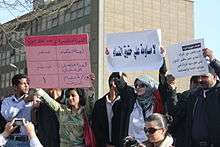
Women have been engaging in efforts to challenge the gender inequality resulting from purdah. For instance, women in Pakistan (mainly from the middle and upper-classes) organized trade unions and exercise their right to vote and influence decision making.[9] However, their opponents accuse these women of falling for the pernicious influence of Westernization and turning their backs on tradition.[9][25]
Globalization and migration
Globalization and Muslim women returning from diasporas has influenced Pakistani women's purdah practice in areas outside of religious significance.[5] One major influence is the desire to be modern and keep up with latest fashion or refusal to do so as a source of autonomy and power.[5] Simultaneously, due to modernization in many urban areas, purdah and face-veiling are seen as unsophisticated and backwards, creating a trend in less strict observance of purdah.[11]
For the Muslim South Asian diaspora living in secular non-Muslim communities such as Pakistani-Americans, attitudes about purdah have changed to be less strict.[26] As it pertains to education and economic opportunities, these immigrant families hold less conservative views about purdah after moving to America; for the daughters who do choose to wear the veil, they usually do so out of their own volition as a connection to their Islamic roots and culture.[26][27]
Controversy around women's agency
Purdah as protection
Some scholars argue that purdah was originally designed to protect women from being harassed and seen as sexual objects.[1] In contemporary times, some men and women still interpret the purdah as a way to protect women's safety while moving in public sphere.[5] Observing purdah is also seen as a way to uphold women's honor and virtuous conduct.[5] However, critics point out that this view engages victim-blaming and places the onus of preventing sexual assault on women rather than the perpetrators themselves.[28]
Purdah as oppression
Purdah has repeatedly been criticized as oppression of women by limiting female autonomy, freedom of movement, and access to resources such as education, employment, and political participation.[29] Some scholars such as P. Singh and Roy interpret purdah as a form of male domination in the public sphere, and an "eclipse of Muslim woman's identity and individuality".[30] According to scholars such as Elizabeth White, "purdah is an accommodation to and a means of perpetuating the perceived differences between the sexes: the male being self-reliant and aggressive, the female weak, irresponsible, and in need of protection".[31] Geraldine Books writes "in both cases [of spatial separation and veiling], women are expected to sacrifice their comfort and freedom to service the requirements of male sexuality: either to repress or to stimulate the male sex urge".[28]
When purdah is institutionalized into laws, it limits opportunity, autonomy, and agency in both private and public life.[5] The result is policies that reinforce cultural norms that limit female mobility in the public sphere, promotion of gender segregation, and institutionalization of gender disparities.[24]
Sometimes reactions to purdah adherence can become violent. For instance in 2001 in Srinagar, India, four young Muslim women were victimized by acid attacks for not veiling themselves in public; similar threats and attacks have occurred in Pakistan and Kashmir.[32]
Purdah as empowerment
The revival of purdah in modern times is sometimes perceived as a statement for progressive gender relations. Some women wear veils and head coverings as a symbol for protection and freedom of mobility. They perceive purdah as an empowerment tool, to exercise their rights to access public space for education and economic independence. For instance, in rural Bangladeshi villages, women who wear the burkha were found to have higher social participation and visibility, which overall contributes to an increase in women's status.[33]
See also
- Andaruni
- Awrah
- Burqa
- Chador
- Dupatta
- Ghoonghat
- Hijab
- Hijab by country
- Sex segregation and Islam
- Women in Islam
- Women in Pakistan
- Zenana
References
- 1 2 3 Asha, S. "Narrative Discourses on Purdah in the Subcontinent." ICFAI Journal of English Studies 3, no. 2 (June 2008): 41–51
- ↑ Ahmed, Leila. ‘Women and the Advent of Islam.' Women Living under Muslim Laws June 1989 - Mar. 1990, 7/8 : 5-15
- 1 2 3 4 5 "Purdah (Islamic Custom) -- Britannica Online Encyclopedia." Accessed February 17, 2013. http://www.britannica.com/EBchecked/topic/483829/purdah
- ↑ Misra, Rekha (1967). Women in Mughal India. New Delhi: Munshiram Manoharlal. p. 135. OCLC 473530.
- 1 2 3 4 5 6 7 8 9 10 11 12 13 Haque, Riffat. "Gender and Nexus of Purdah Culture in Public Policy." South Asian Studies (1026-678X) 25, no. 2 (July 2010): 303–310
- ↑ Khazan, Olga (21 June 2013). "Face Veils and the Saudi Arabian Plague". The Atlantic. The Atlantic Media Company. Retrieved 19 February 2015.
- ↑ Harnischfeger, Johannes (2014). "Boko Haram and its Muslim critics: Observations from Yobe State". In Pérouse de Montclos, Marc-Antoine. Boko Haram: Islamism, politics, security and the state in Nigeria (PDF). Leiden, Netherlands: African Studies Centre (ASC). p. 41. ISBN 978-90-5448-135-5. Retrieved 19 February 2015.
Both rich and poor presented themselves as pious Muslims but took a very limited, selfish interest in the law of God. Most kept their wives in purdah but had little compunction committing adultery with unmarried girls.
- ↑ "Rajput". Encyclopaedia Britannica. Retrieved 30 October 2014.
- 1 2 3 4 Shaheed, F. "The Cultural Articulation of Patriarchy: Legal Systems, Islam and Women." South Asia Bulletin 6, no. 1 (1986): 38–44.
- ↑ Arnett, Susan. King's College History Department, "Purdah." Last modified 2001. Accessed March 18, 2013. http://departments.kings.edu/womens_history/purdah.html.
- 1 2 Veiling and the Seclusion of Women. US Library of Congress
- ↑ Naim, C.M. 2004. "The Hijab and I." Outlook Magazine
- 1 2 Papanek, Hanna. "Purdah: Separate Worlds and Symbolic Shelter." Comparative Studies in Society and History 15, no. 03 (1973): 289–325. doi:10.1017/S001041750000712X.
- 1 2 Michael A. Koenig, Saifuddin Ahmed, Mian Bazle Hossain, and A. B. M. Khorshed Alam Mozumder. "Women's Status and Domestic Violence in Rural Bangladesh: Individual- and Community-level Effects." Demography 40, no. 2 (May 1, 2003): 269–288. doi:10.1353/dem.2003.0014.
- ↑ Khan, Ayesha. "Mobility of Women and Access to Health and Family Planning Services in Pakistan." Reproductive Health Matters 7, no. 14 (November 1999): 39–48. doi:10.1016/S0968-8080(99)90005-8.
- ↑ Hossain, M. K., and M. Kabir. "Purdah, Mobility and Women's Empowerment and Reproductive Behaviour in Rural Bangladesh." Social Change 31, no. 3 (September 1, 2001): 84–102. doi:10.1177/004908570103100307.
- 1 2 Hashemi, Syed M., Sidney Ruth Schuler, and Ann P. Riley. "Rural Credit Programs and Women's Empowerment in Bangladesh." World Development 24, no. 4 (April 1996): 635–653. doi:10.1016/0305-750X(95)00159-A.
- ↑ Kabeer, N. "Poverty, purdah and women's survival strategies in rural Bangladesh." (1990): 134–148.
- ↑ Amin, Sajeda. "The Poverty–Purdah Trap in Rural Bangladesh: Implications for Women's Roles in the Family." Development and Change 28, no. 2 (1997): 213–233. doi 10.1111/1467-7660.00041.
- ↑ Turkey headscarf ruling condemned Al Jazeera English (07 June 2008). Retrieved on February 2013.
- ↑ Abdelhadi, Magdi Tunisia attacked over headscarves, BBC News, September 26, 2006. Accessed February 2013.
- ↑ French MPs back headscarf ban BBC News (BBC). Retrieved on 13 February 2009.
- ↑ Shahab, Rafi Ullah. (1993). Muslim Women in Political Power. Lahore: Maqbool Academy
- 1 2 Jalal, Ayesha (1991). The Convenience of Subservience: Women in the State of Pakistan. Kandiyoti, Deniz., Women, Islam and the State. Philadelphia: Temple University Press
- ↑ Facing History and Ourselves (2008). Stories of Identity: Religion, Migration, and Belonging in a Changing World. Brooklin , MA, USA: Facing History and Ourselves Foundation, Inc. p. 101. ISBN 978-0-9798440-3-4.
- 1 2 Bokhari, Syeda Saba. "Attitudes of Migrant Pakistani-muslim Families Towards Purdah and the Education of Women in a Secular Environment." Dissertation Abstracts International. Section A: Humanities and Social Sciences 58, no. 01 (July 1997): 193–193.
- ↑ Marco, Oihana. "The Hijabization Process: Some "Mindful" Bodies Uncovered" (PDF). Iemed.org. Retrieved 16 January 2014.
- 1 2 Brooks, Geraldine. Nine Parts of Desire: The Hidden World of Islamic Women. New York: Doubleday, 1995.
- ↑ Engineer, Asghar Ali. (1980) The Origin and Development of Islam, Orient Longman, Bombay
- ↑ Singh, Prahlad (2004). "Purdah: the seclusion of body and mind". Abstracts of Sikh Studies, Vol 5, issue 1
- ↑ White, Elizabeth H. "Purdah." Frontiers: A Journal of Women Studies 2, no. 1 (April 1, 1977): 31–42. doi:10.2307/3346105
- ↑ Nelson, Dean. "Kashmir women ordered to cover up or risk acid attack." The Telegraph, , sec. World, August 13, 2012. http://www.telegraph.co.uk/news/worldnews/asia/india/9472909/Kashmir-women-ordered-to-cover-up-or-risk-acid-attack.html (accessed March 18, 2013).
- ↑ Feldman, Shelley, and Florence McCarthy. "Purdah and Changing Patterns of Social Control among Rural Women in Bangladesh." Journal of Marriage and Family. 45. no. 4 (1983): 949-959. http://www.jstor.org/stable/351808 . (accessed February 17, 2013).
Further reading
- Bauman, Chad M. "Redeeming Indian" Christian" Womanhood?: Missionaries, Dalits, and Agency in Colonial India." Journal of Feminist Studies in Religion 24.2 (2008): 5-27.
- Chowdhry, Prem. The veiled women: Shifting gender equations in rural Haryana, 1880-1990 (Delhi: Oxford University Press, 1994)
- Lamb, Sarah. White saris and sweet mangoes: Aging, gender, and body in North India (Univ of California Press, 2000)
- Minturn, Leigh. Sita's daughters: Coming out of purdah: The Rajput women of Khalapur revisited (Oxford University Press, 1993)
- Nanda, Bal Ram, ed. Indian Women: From Purdah to Modernity (Stosius Incorporated/Advent Books Division, 1990.)
- Vyas, Sugandha Rawat, and Pradeep Kumar. "From Sultanate Period Till Date: An Estimate Of Role and Status of Muslim Women in India." Journal of Indian Research (2014) 2#3 pp: 9-14.
Historiography
- Johnson, Helen. "Purdah" in Eleanor B. Amico, ed., Readers Guide to Women's Studies (1998) pp 484-5
